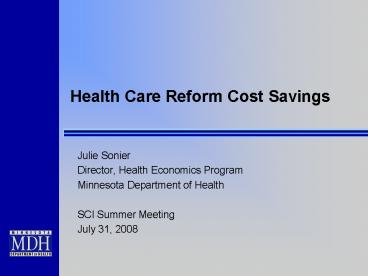Health Care Reform Cost Savings - PowerPoint PPT Presentation
Title:
Health Care Reform Cost Savings
Description:
Title: Title of show Author: State of Mn Last modified by: Colin McGlynn Created Date: 11/20/2000 4:02:02 PM Document presentation format: On-screen Show – PowerPoint PPT presentation
Number of Views:22
Avg rating:3.0/5.0
Title: Health Care Reform Cost Savings
1
Health Care Reform Cost Savings
- Julie Sonier
- Director, Health Economics Program
- Minnesota Department of Health
- SCI Summer Meeting
- July 31, 2008
2
Key Questions
- What are the potential savings associated with
health care reform? - Potential is believed to be significant, but is
difficult to demonstrate - How can savings be measured?
- How can savings be captured for other uses
(such as coverage expansion)?
3
Issues in Estimating and Capturing Savings
- Lack of research studies documenting or
estimating savings - Many reform ideas have not been tried on a large
scale - Some have been tried but are too new to have
generated much evidence - No guarantees that potential savings will
materialize - Hard to predict interactions in complex system
- Success of many reforms depends on buy-in and
engagement of a wide range of stakeholders - Savings are systemwide, and not necessarily
bookable for state budget purposes - Savings are more likely to materialize as lower
rates of spending growth than reductions in the
level of spending
4
Major Sources of Potential Savings in Minnesotas
2008 Health Reform Law
- Population health improvement
- Overweight/obesity and tobacco use result in
demonstrably higher health care costs - Reducing their prevalence should save money
- Payment reform
- Administrative efficiency
5
Impact of Rising Obesity on Health Care
Costs(Ken Thorpe study using national data)
- Increasing prevalence
- Between 1987 and 2001, obesity prevalence
increased 10.3 percentage points, while normal
weight prevalence declined 13 percentage points - Increasing gap between health care spending for
obese vs normal weight population - Difference grew from 15 to 37 between 1987 and
2001 - As a result of both these factors,
obesity-related health spending accounted for an
estimated 27 of inflation-adjusted per capita
health spending increases - 41 of the rise in heart disease spending
- 38 of the rise in diabetes-related spending
Source Thorpe et al., The Impact of Obesity on
Rising Medical Spending, Health Affairs, October
2004.
6
How Is Payment Reform Expected to Result in
Savings?
- Sources of potential savings
- Consumers will shift to lower-cost providers
- State employee group experience shows that
consumers are price sensitive - Increased provider competition on price
- Again, state employee group experience shows that
providers will lower prices to get into preferred
tiers - Provider incentives to re-design delivery of care
in ways that provide higher quality care at lower
cost - Reduce the need for expensive, avoidable
interventions - Reduce investment in and use of supply
sensitive or preference sensitive services
7
Other Evidence/Experience Related to Potential
Savings from Payment Reform
- Medicare
- Wide variations in utilization and cost, and no
association (or a negative association) with
quality or health outcomes - Estimated potential savings up to 30 from
reducing variations in practice patterns - Minnesota state employee group
- 63 difference between highest-cost and
lowest-cost provider groups (risk-adjusted) - Buyers Health Care Action Group
- Care system bidding for total cost of care for
a patient population in 1990s - Ultimately, this coalition of large private
employers (about 200,000 covered lives at its
peak) lacked the critical mass needed to move the
market
Wennberg et al., Geography and the Debate Over
Medicare Reform, Health Affairs web exclusive,
February 13, 2002.
8
Key Issues for Realizing Savings Through Payment
Reform
- The delivery system will only change if
- Consumers have a reason to consider cost and
quality in making decisions - Insurance benefit sets
- Available information on variation in cost and
quality - Providers are rewarded for providing care more
efficiently and avoiding unnecessary services - Need to pay explicitly for things like care
coordination, and align financial incentives - There is a critical mass of health plans,
purchasers, and consumers committed to changing
the status quo
9
Administrative Efficiency
- Implementing fully interoperable electronic
health records estimated at 4.3 potential net
long-term savings in a report for the State of
Oregon - Savings are a result of both reduced medical
costs (1/3) and increased productivity and lower
administrative costs (2/3) - Requires substantial up-front investment
- Administrative transaction simplification
- Estimated 215 million in savings for FY
2008-2012 by implementing standard electronic
transactions for - Eligibility verification
- Health care claims
- Payment and remittance advice
10
What Have We Learned in Minnesota?
- There is no magic model with the answers to
these complex questions - Its much more an art than a science
- But there are reasonable ways to ballpark
potential savings - Take advantage of the information that is out
there - Use examples from national research
- Dartmouth Atlas work on variations in cost and
utilization - Thorpe work on obesity
- Commonwealth Funds Bending the Curve report
- Use examples and reports from other states
11
Measuring and Tracking Savings
- Savings from 2008 health reforms will be tracked,
in an aggregate way - Project health care spending in the absence of
reform, measure actual spending, and define the
difference as savings - When 50 million in savings is certified,
repayment of a loan from the health care access
fund to the general fund is triggered - Not the same as savings recapture, since this
transaction is just a shift of funds within state
government - Earlier versions of the health reform bill
included a savings recapture mechanism based on
the difference between projected and actual
spending
12
Contact Information
Julie Sonier, Director Health Economics
Program Minnesota Department of Health 651
201-3561 julie.sonier_at_state.mn.us Website
www.health.state.mn.us/healtheconomics

